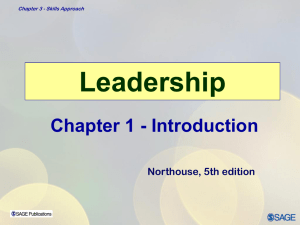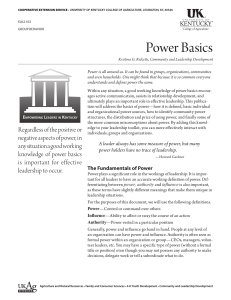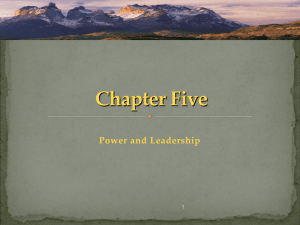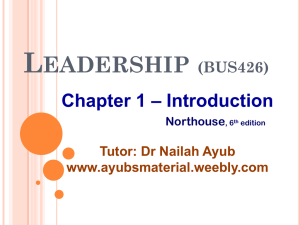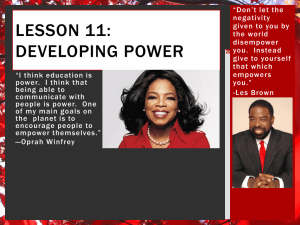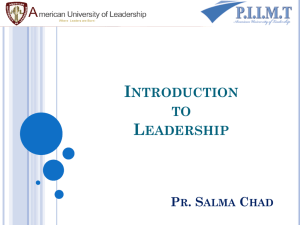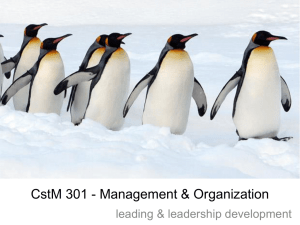Leadership Chapter 1
advertisement
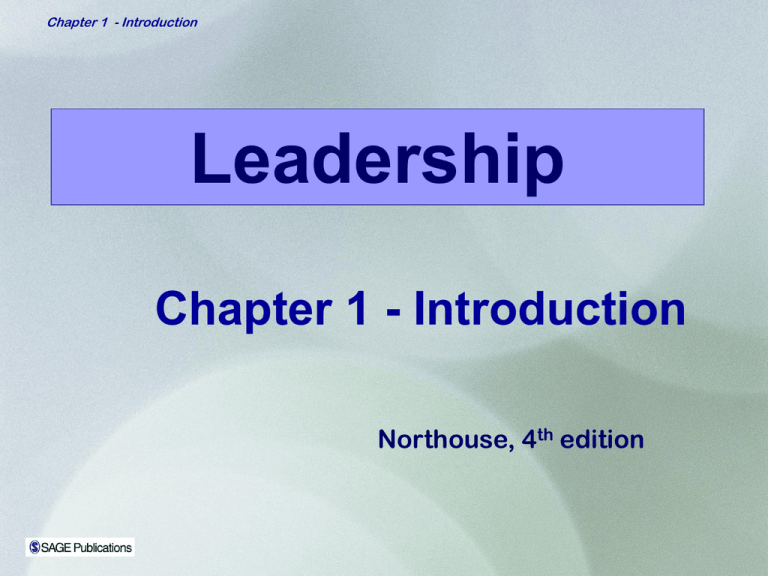
Chapter 1 - Introduction Leadership Chapter 1 - Introduction Northouse, 4th edition Chapter 1 - Introduction Overview Conceptualizing Leadership Leadership Definition Components of the Definition Followers & Leadership Chapter 1 - Introduction Conceptualizing Leadership Some definitions view leadership as: The focus of group processes A personality perspective An act or behavior In terms of the power relationship between leaders & followers An instrument of goal achievement A skills perspective Chapter 1 - Introduction Leadership Defined Leadership is a process whereby an individual influences a group of individuals to achieve a common goal. Chapter 1 - Introduction Components Central to the Phenomenon of Leadership Leadership Is a process Involves influence Occurs within a group context Involves goal attainment Leaders Are not above followers Are not better than followers Rather, an interactive relationship with followers Chapter 1 - Introduction LEADERSHIP DESCRIBED Trait vs. Process Leadership Assigned vs. Emergent Leadership Leadership & Power Leadership & Coercion Leadership & Management Chapter 1 - Introduction Trait vs. Process Leadership Trait definition of leadership: Certain individuals have special innate or inborn characteristics or qualities that differentiate them from nonleaders. – Resides in select people – Restricted to those with inborn talent LEADER Leadership • Height • Intelligence • Extroversion • Fluency • Other Traits FOLLOWERS Chapter 1 - Introduction Trait vs. Process Leadership The process definition of Leadership: Leadership is a property or set of properties possessed in varying degrees by different people (Jago, 1982). LEADER Leadership (Interaction) – Observed in leadership behaviors – Can be learned FOLLOWERS Chapter 1 - Introduction Assigned vs. Emergent Leadership Assigned Leadership based on occupying a position within an organization – – – – Team leaders Plant managers Department heads Directors Emergent An individual perceived by others as the most influential member of a group or organization regardless of the individual’s title – Emerges over time through communication behaviors Verbal involvement Being informed Seek other’s opinions Being firm but not rigid Chapter 1 - Introduction Leadership & Power Power The capacity or potential to influence. – Ability to affect others’ beliefs, attitudes & actions Bases of Social Power French & Raven (1959) Referent Expert Legitimate Reward Power is a relational concern for both leaders and followers. Coercive Chapter 1 - Introduction Leadership & Power Five Bases of Power Chapter 1 - Introduction Leadership & Power Five Bases of Power REFERENT POWER – Based on followers’ identification and liking for the leader. – ex. A schoolteacher who is adored by her students has referent power. EXPERT POWER – Based on followers’ perceptions of the leader’s competence. – ex. A tour guide who is knowledgeable about a foreign country has expert power. LEGITIMATE POWER – Associated with having status or formal job authority. – ex. A judge who administers sentences in the courtroom exhibits legitimate power Chapter 1 - Introduction Leadership & Power Five Bases of Power REWARD POWER – Derived from having the capacity to provide rewards to others. – ex. A supervisor who gives rewards to employees who work hard is using reward power. COERCIVE POWER – Derived from having the capacity to penalize or punish others. – ex. A coach who sits players on the bench for being late to practice is using coercive power. Chapter 1 - Introduction Leadership & Power Types and Bases of Power Position Power Power derived from office or rank in an organization – Legitimate – Reward – Coercive Personal Power Power is influence derived from being seen as likable & knowledgeable – Referent – Expert Chapter 1 - Introduction Leadership & Coercion Coercion Involves Use of force to effect change Influencing others to do something via manipulation of rewards and penalties in the work environment Use of threats, punishments, & negative rewards Examples of Coercive Leaders Adolf Hitler Jim Jones David Koresh Power & restraint used to force followers to engage in extreme behavior Chapter 1 - Introduction Leadership & Management Kotter (1990) Management Activities “Produces order and consistency” Leadership Activities “Produces change and movement” • Planning & Budgeting • Establishing direction • Organizing & Staffing • Aligning people • Controlling & Problem Solving • Motivating / Inspiring Major activities of management & leadership are played out differently; BUT, both are essential for an organization to prosper. Leadership & Management Chapter 1 - Introduction Kotter (1990) Major activities of management and leadership are played out differently; BUT, both are essential for an organization to prosper. Chapter 1 - Introduction Leadership & Management Zaleznik (1977) Managers Leaders Unidirectional Authority Multidirectional Influence • Are reactive • Prefer to work with people on problem solving • Low emotional involvement • Are emotionally active & involved • Shape ideas over responding to them • Act to expand available options • Change the way people think about what is possible
